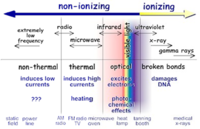
Photo from wikipedia
OBJECTIVE Glioma is a malignant brain cancer capable of spreading to the microenvironment. Long non-coding RNA (lncRNA) X inactive specific transcript (XIST) was recognized as a significant regulator in many… Click to show full abstract
OBJECTIVE Glioma is a malignant brain cancer capable of spreading to the microenvironment. Long non-coding RNA (lncRNA) X inactive specific transcript (XIST) was recognized as a significant regulator in many cancers. However, the molecular mechanism of XIST in glioma cell radio-sensitivity requires further exploration. PATIENTS AND METHODS The expression of XIST, microRNA (miR)-329-3p and cyclic AMP response element-binding protein 1 (CREB1) was evaluated by quantitative Real-time polymerase chain reaction (qRT-PCR). Cell viability and apoptosis were examined by 3-(4,5-dimethyl-2-thiazolyl)-2,5-diphenyl-2-H-tetrazolium bromide (MTT) and flow cytometry, respectively. Transwell assay was performed to detect cell invasion. Protein expression of gamma-H2AX (γ-H2AX) and CREB1 was determined by Western blot. The correlation between miR-329-3p and XIST or CREB1 was determined by dual-luciferase reporter assay. Animal models were established by subcutaneously injecting U251 cells transfected with sh-XIST and sh-NC. RESULTS XIST and CREB1 were overexpressed whereas miR-329-3p was low-expressed in glioma tumors and cells compared with the normal counterparts. XIST knockdown inhibited cell proliferation, invasion and induced cell apoptosis by enhancing cell sensitivity to X-ray radiation in glioma. Then, we discovered that miR-329-3p directly interacted with XIST or CREB1 in glioma. In addition, miR-329-3p inhibitor abolished XIST silencing-induced regulatory effects on cell proliferation, apoptosis, invasion, and radio-sensitivity. Meanwhile, miR-329-3p inhibitor counteracted CREB1 silencing-induced inhibition on cell progression and facilitation on radio-sensitivity in glioma. Moreover, we found that XIST could increase CREB1 expression by sponging miR-329-3p. Animal experiments revealed that XIST silencing restrained tumor growth in vivo. CONCLUSIONS XIST accelerates cell proliferation, invasion and inhibits cell apoptosis by repressing radio-sensitivity of glioma via enhancing CREB1 expression through sponging miR-329-3p, representing prospective methods for glioma treatment.
Journal Title: European review for medical and pharmacological sciences
Year Published: 2020
Link to full text (if available)
Share on Social Media: Sign Up to like & get
recommendations!